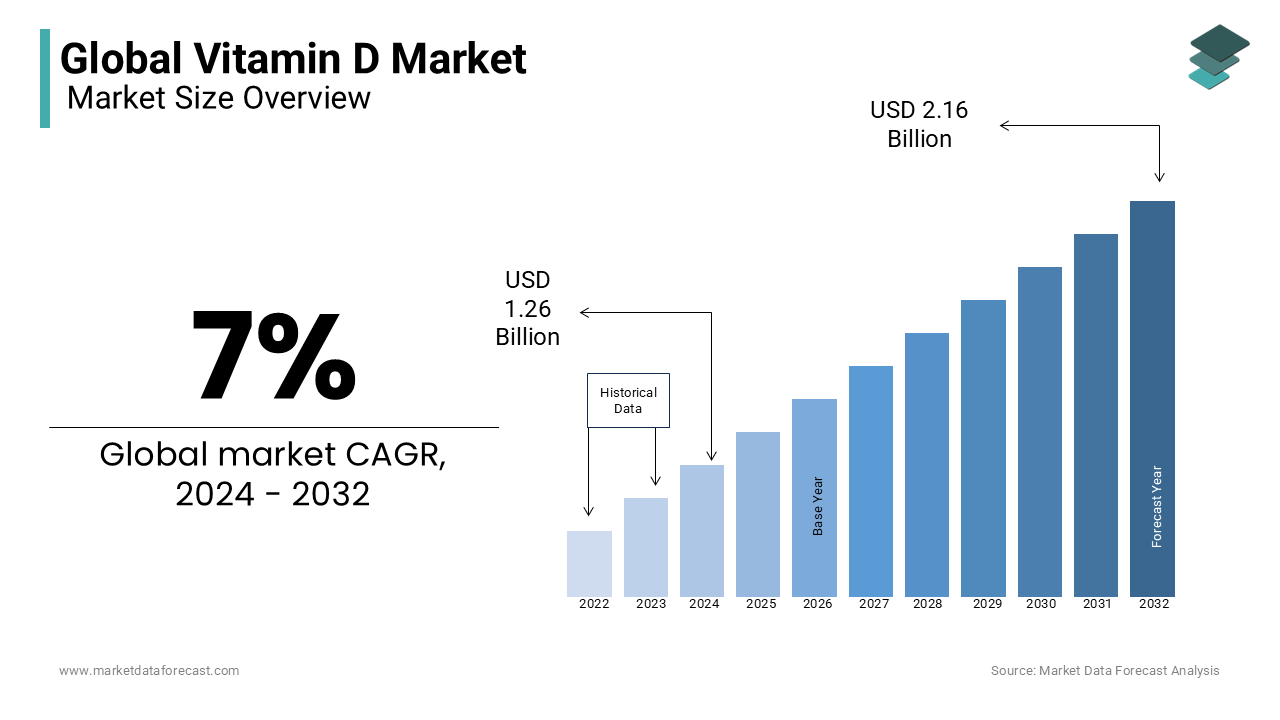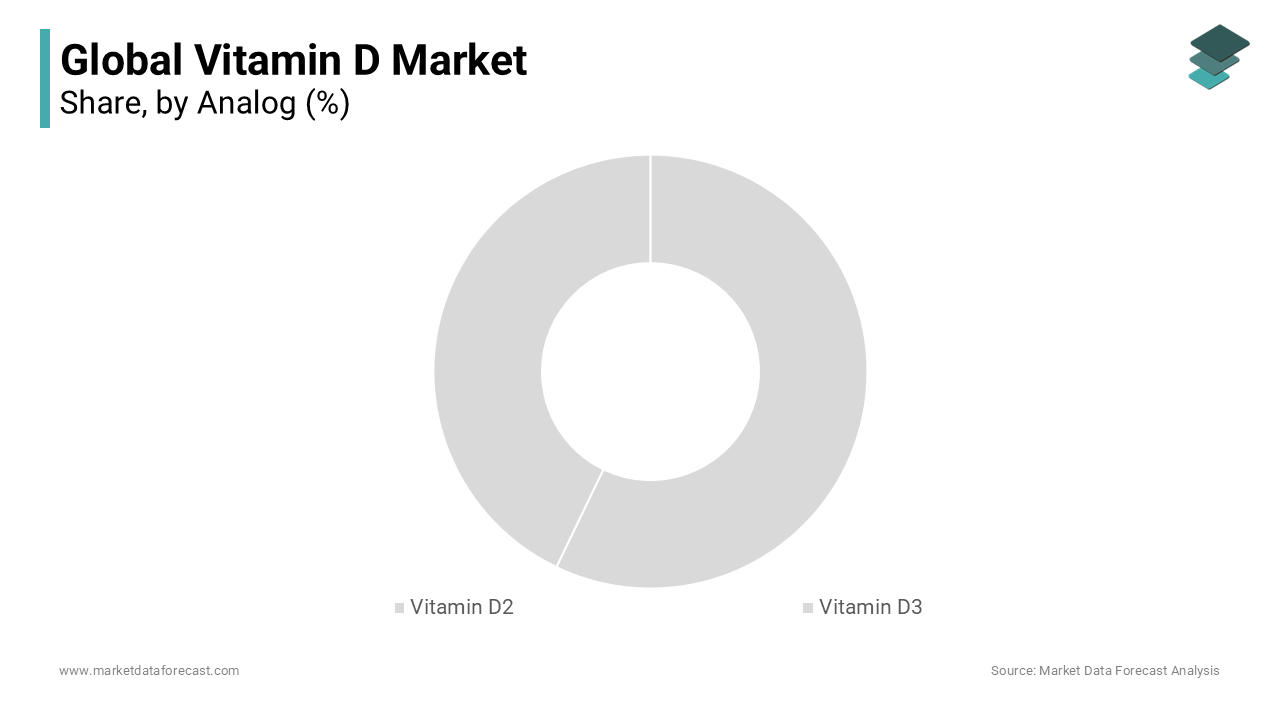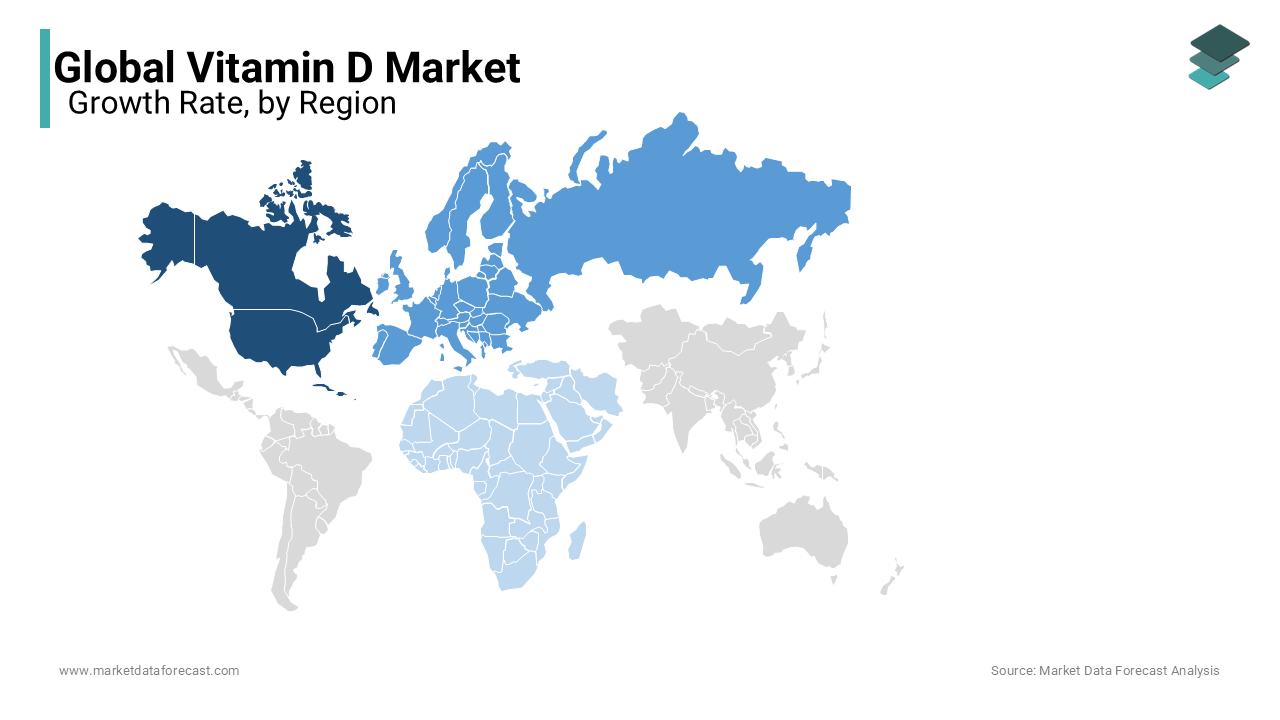Global Vitamin D Market Size, Share, Trends & Growth Forecast Report – Segmented By Analog (Vitamin D2 and Vitamin D3), Application (Pharmaceuticals, Functional Food and Beverage, Personal Care, Pet Food and Animal Feed), End User (Adult, Children and Pregnant Women), And Region (North America, Europe, Asia Pacific, Latin America, and Middle East and Africa) - Industry Analysis (2025 to 2033)
Global Vitamin D Market Size
The global vitamin D market was worth USD 1.26 billion in 2024. It is estimated to grow at a CAGR of 7% from 2025 to 2033 and be worth USD 2.32 billion by 2033, up from USD 1.35 billion in 2025.

Current Scenario of the Global Vitamin D Market
The Vitamin D market has grown significantly in recent years due to increasing awareness of its necessity and benefits. The growing demand for dietary supplements among pregnant women and older adults is enhancing the adoption of Vitamin D, leading to market expansion. The escalating utilization of vitamin D in the food and beverage industry is a crucial driver for global market growth. Due to their health benefits, the increasing demand for functional foods and beverages is enhancing the adoption of vitamin D-rich foods and beverages. The vitamin D market is projected to grow prominently in the coming years due to growing research activities by market players to develop vitamin D supplements. The growing expansion of the pharmaceutical industry worldwide is anticipated to offer growth opportunities to the vitamin D market.
MARKET DRIVERS
The growth of the global vitamin D market is majorly attributed to the increased demand for and consumption of food worldwide.
A group of chemical components or compounds that the human body needs to maintain regular metabolic functions are called vitamins and are divided into A, B, C, D, E, and K according to the functions that human metabolism performs. Because it is fat-soluble, vitamin D occurs naturally in certain foods. It is found mainly in mushrooms, fish, cod liver oil, and egg yolks. Vitamin D is necessary for healthy bone growth. It is also essential for bone regeneration by osteoblasts and osteoclasts. It also helps prevent osteoporosis and osteoporosis in adults and rickets in children. Vitamin D is a steroid vitamin that promotes intestinal absorption and calcium and phosphorus metabolism. Under average exposure to sunlight, no dietary supplements are needed, as sunlight promotes the adequate synthesis of vitamin D for the skin. Vitamin D deficiency can lead to bone deformation (rickets) in children and bone weakness in adults. Vitamin D is consumed in food, found in eggs, fish, and dairy products, and produced in human skin. The production of skin in the active form of vitamin D depends on exposure to sunlight at the beginning of the day. People living in sunny areas produce most of the vitamin D necessary for the skin.
The food industry is experiencing increased demand for improved food products, supporting the need for nutritional additives such as vitamin D.
Vitamin D is a fat-soluble vitamin mainly found in foods such as meat and eggs and is absorbed by the body as a supplement. Although body-specific synthesis or hydroxylation is necessary for vitamin D, exposure to the sun for some time meets the requirement. The growing awareness regarding the significance of blood circulation and preventing the development of hypocalcemia, osteoporosis, osteomalacia, rickets, and thyroid function in the human body is boosting the consumption of vitamin D and propelling the global market growth. The surge in the incidence of the ailments mentioned above improved the intake of Vitamin D supplements, and suggestions by certified professionals for the consumption of vitamin D intake are also influencing the market positively.
The growing population with Vitamin D deficiency, increasing number of medical referrals and child malnutrition further accelerate the expansion of the global vitamin D market.
Vitamin D is necessary for human bodies, including healthy growth, development of teeth and bones, defense against muscle weakness, proper thyroid function and blood clotting, and heart regulation. This consumer awareness proliferates worldwide, increasing consumption and global market growth. The regulatory body's favorable regulation of trade in vitamin D ingredients is a significant growth driver in the worldwide market. This allows vitamin D manufacturers to sell their products without any restrictions. This aspect is advantageous for pharmaceutical companies because it is easy to sell vitamin D-based products. Also, the global market for vitamin D ingredients is being activated due to increased investment by regulators to announce benefits related to using vitamin D products. This is provided to increase the demand for vitamin D ingredients in many food applications. Also, vitamin D drinks are easy to consume and digest. Therefore, vitamin D beverages are gaining immense popularity among consumers. The pharmaceutical sector may also strengthen the global market for vitamin D ingredients shortly, thanks to the efforts of pharmaceutical companies to encourage the use of vitamin D products.
MARKET RESTRAINTS
Regulatory standards implemented to prevent extreme use will slow down global market growth in some regions.
Overdose can cause vomiting, loss of appetite, nausea, headache, and depression. Vitamin D absorbs phosphorus and calcium from the intestine. Pharmaceutical products that inhibit market growth include regulatory standards imposed in certain regions to prevent undesirable vitamin D toxicity.
REPORT COVERAGE
|
REPORT METRIC |
DETAILS |
|
Market Size Available |
2024 to 2033 |
|
Base Year |
2024 |
|
Forecast Period |
2025 to 2033 |
|
CAGR |
7% |
|
Segments Covered |
By Analog, Application,End User, and Region |
|
Various Analyses Covered |
Global, Regional & Country Level Analysis, Segment-Level Analysis, DROC, PESTLE Analysis, Porter’s Five Forces Analysis, Competitive Landscape, Analyst Overview of Investment Opportunities |
|
Regions Covered |
North America, Europe, APAC, Latin America, Middle East & Africa |
|
Market Leaders Profiled |
Nestlé S.A, BASF, Pfizer, Inc., Koninklijke DSM N.V., ADM Alliance Nutrition, Inc., and Kraft Foods Group. |
SEGMENTAL ANALYSIS
Global Vitamin D Market Analysis By Analog

The vitamin D3 segment accounted for the dominant market share in 2023 and is estimated to maintain its dominance during the forecast period. Vitamin D3, known as cholecalciferol, is mainly obtained from animal sources like egg yolk and fish oil. Vitamin D3 is widely adopted in the pharmaceutical industry as it enhances health and supports the treatment of illness. Various researchers state that vitamin D3 works better than D2 at raising the serum levels of 25-hydroxyvitamin D, which drives segment growth.
The vitamin D2 segment is estimated to grow steadily during the forecast period. Vitamin D2 is known as ergocalciferol, which is derived from the common plant steroid ergosterol. The wide availability of vitamin D2 at lower costs and its vast adoption in the formulation of fortified foods are boosting the market growth in this segment.
Global Vitamin D Market Analysis By Application
The pharmaceuticals segment dominated the global Vitamin D market revenue with a significant share in 2023—the growing applications of vitamin D in pharmaceuticals such as vitamin therapy and dietary supplements. The presence of vitamin D is crucial for the absorption of calcium in the body. Both vitamin D2 and D3 are used in treating depression, enhancing immunity, and reducing tiredness and muscle weakness, fueling the segment's growth and leading to global market expansion.
The functional food and beverages segment is estimated to grow the fastest during the forecast period due to the increased use of vitamin D in food supplements and various functional beverages. The FDA approved the use of vitamin D as a food additive in specific categories, such as fruit juices, meal replacement bars, drinks, and others, which is driving the segment's growth.
Global Vitamin D Market Analysis By End-User
The adult segment dominated the global vitamin D market with a significant share of the global market in 2023. The lead of the adult segment is estimated to continue during the forecast period as vitamin D deficiency is more prevalent among people 50. Severe vitamin deficiency leads to osteomalacia, osteopenia, and osteoporosis, raising these people's adoption of vitamin D supplements. According to the National Centre for Biotechnology Information (NCBI), there is a reduced concentration of 7-dehydrocholestrol in the epidermis of the older population, which further disables to an adequate response to U.V. light, which leads to a 50% decrease in the formation of pre-vitamin D3 in their bodies.
The pregnant women segment is estimated to grow prominently during the forecast period. Vitamin D supplements are crucial for pregnant women, as they require calcium for the body. The growing number of pregnant women across countries is boosting the segment growth.
REGIONAL ANALYSIS

North America was the largest regional segment in the worldwide market in 2023.
North America accounted for 36.6% of the global market share in 2023 and is expected to continue to dominate the market during the forecast period. This growth is primarily due to America's prosperity in the vitamin D market and this trend is likely to continue in the future. The growing population with vitamin D deficiency in North American countries is boosting the consumption of vitamin D and driving the vitamin D market growth in North America. Most of the United States population is deficient in vitamin D. This has increased the demand for ingredients in this area because deficiencies cause diabetes, skin cancer, and heart disease. Research published in North America suggests a link between vitamin D supplementation to reduce autoimmune symptoms, reduced risk of fractures, and the prevention of certain cancers in specific subsets of the U.S. population and the scientific evidence supports opposing views. It has been regarded as one of the most lucrative vitamin D supplement market opportunities. As the trend of vegetarianism increases worldwide, North American consumers have preferred supplements adapted to vitamin D2 rather than vitamin D3. For example, vitamin D2 is most commonly used to strengthen milk in the United States. The North American population is greatly affected by vitamin D deficiency, causing rickets. This leads to a demand for vitamin D supplements. Fostering government policy and increasing consumer interest in health will spur regional growth.
Europe played a prominent role in the global vitamin D market in 2023.
Europe had the second-largest share of the global market in 2023 and is likely to register a notable CAGR during the forecast period. An increasing number of initiatives and fortification of vitamin D programs by the governments of European countries promotes the European vitamin D market growth. For instance, the government of Finland announced a mandate for vitamin D fortification in dairy products to reduce the vitamin D deficiency rates among the population, and as a result, the deficiency rate has been gradually reducing in the last decade in Finland. France, Germany, the United Kingdom, and Italy mainly drive Europe's global vitamin D market. This growth may have been attributed to significant gains, as the range of applications in the pharmaceutical and personal care industries has been expanded to promote market growth in the region.
Asia-Pacific is expected to experience promising growth during the forecast period in the global market.
The Asia-Pacific region held a considerable share of the worldwide market in 2023 and is projected to witness rapid growth during the forecast period. Factors such as initiatives from the governments of Asia-Pacific countries to address malnutrition and vitamin deficiencies, increasing middle class population and rising demand for vitamin D supplements are propelling the growth of the vitamin D market in Asia-Pacific region.Korea, India, China, and Japan fuel growth in the Asia-Pacific region in the world market. China and India are among the most favorable markets for expanding vitamin D manufacturers due to the increased demand for animal feed, food fortification, and the easy availability of raw materials.
The demand for vitamin D products in Latin America is on the rise.
Latin America is estimated to grow at a healthy CAGR during the forecast period. The growing awareness among the population of Latin America of the benefits of vitamin D and an increasing number of initiatives of Latin American governments are propelling the Latin American vitamin D market growth. Brazil and Mexico are likely to account for most of the share of the Latin American market during the forecast period.
The Middle East and Africa vitamin D market is anticipated to progress steadily during the forecast period.
The demand for vitamin D is growing gradually in the Middle East and African region as the population suffering from vitamin D deficiency is high in the countries of the Middle East and Africa. To address this growing concern of vitamin D deficiency, the governments of MEA countries have been implementing several campaigns to boost awareness among people. Saudi ra
KEY PLAYERS IN THE GLOBAL VITAMIN D MARKET
Companies leading in the global vitamin D market include Nestlé S.A, BASF, Pfizer, Inc., Koninklijke DSM N.V., ADM Alliance Nutrition, Inc., and Kraft Foods Group.
RECENT HAPPENINGS IN THE MARKET
- In May 2023, Great Britain approved Lalmin Vita D vitamin D yeast for more categories. Food supplements and pre-packed dry or fresh yeast packs for home baking are already made with this ingredient in Great Britain.
- In May 2023, Koios Beverage Corp introduced a new, innovative "Swol Bears" gummy line. This new line of gummy candies is made with all-natural ingredients and infused with vitamin D, providing consumers with a healthier and more delicious snacking option.
- In July 2023, PanGenomic Health Inc. announced that its subsidiary, MUJN Diagnostics Inc., launched a vitamin D health assessment service and a corporate website at mujn.ai.
- In July 2023, Chewsy, a manufacturer of tasty and innovative vitamin chews, introduced three new products to CVS pharmacy customers nationwide, where these chewable vitamins help consumers reach their beauty and wellness goals. The product consists of essential B vitamins, Vitamin D, and biotin for beautiful hair and prolonged stress.
- In August 2022, M.D. Pharmaceuticals, a Singapore-based healthcare distributor, developed a new Vitamin D supplement called Rapid-D with DSM.
- In July 2022, KaraMD, a US-based company, launched Pure D3 Plus, a vitamin D3 and magnesium supplement. This product is expected to strengthen heart and bone health by boosting immunity and reducing cardiovascular disease risks.
- In January 2018, the FDA approved an increase in vitamin D consumption, which would be added as an optional ingredient in milk. It is also used in soy, coconut, edible vegetable yogurt, and almond drinks. This approval allows manufacturers to add elements to various foods.
- In December 2016, Professor John McGrath of the Queensland Cerebral Institute led the research team. The team found that babies of pregnant women who were not taking vitamin D supplements were more prone to autism. Therefore, medicines specially formulated for pregnant women will present future opportunities for the market.
- In January 2019, Fermenta Biotech Limited (India) signed a 99-year lease to acquire approximately 40,000 square meters of land from the Gujarat Industrial Development Corporation (GIDC) authority, Ankleshwar, for future expansion.
DETAILED SEGMENTATION OF THE GLOBAL VITAMIN D MARKET INCLUDED IN THIS REPORT
This research report on the global vitamin D market has been segmented and sub-segmented based on analog, application, End User, and region.
By Analog
- Vitamin D2
- Vitamin D3
By Application
- Functional Food and Beverages
- Pharmaceuticals
- Animal Feed and Pet Food
- Personal Care
- Others
By End-User
- Children
- Adult
- Pregnant Women
By Region
- North America
- Asia Pacific
- Europe
- Latin America
- Middle East and Africa
Frequently Asked Questions
1. What are the key factors driving the growth of the Vitamin D market?
Factors such as increasing awareness about Vitamin D deficiency, rising demand for fortified foods and supplements, growing health concerns, and the prevalence of lifestyle diseases are driving the growth of the Vitamin D market.
2. What are the main sources of Vitamin D used in supplements?
The primary sources of Vitamin D used in supplements include Vitamin D3 (cholecalciferol) derived from animal sources like fish oil, lanolin (sheep's wool), and Vitamin D2 (ergocalciferol) derived from plant sources like mushrooms and yeast.
3. What are the key market trends in the Vitamin D industry?
Some key trends in the Vitamin D industry include the development of novel delivery formats such as gummies and chewable tablets, introducing vegan and vegetarian-friendly Vitamin D supplements, and integrating Vitamin D into functional foods and beverages.
Related Reports
Access the study in MULTIPLE FORMATS
Purchase options starting from
$ 2500
Didn’t find what you’re looking for?
TALK TO OUR ANALYST TEAM
Need something within your budget?
NO WORRIES! WE GOT YOU COVERED!
Call us on: +1 888 702 9696 (U.S Toll Free)
Write to us: sales@marketdataforecast.com